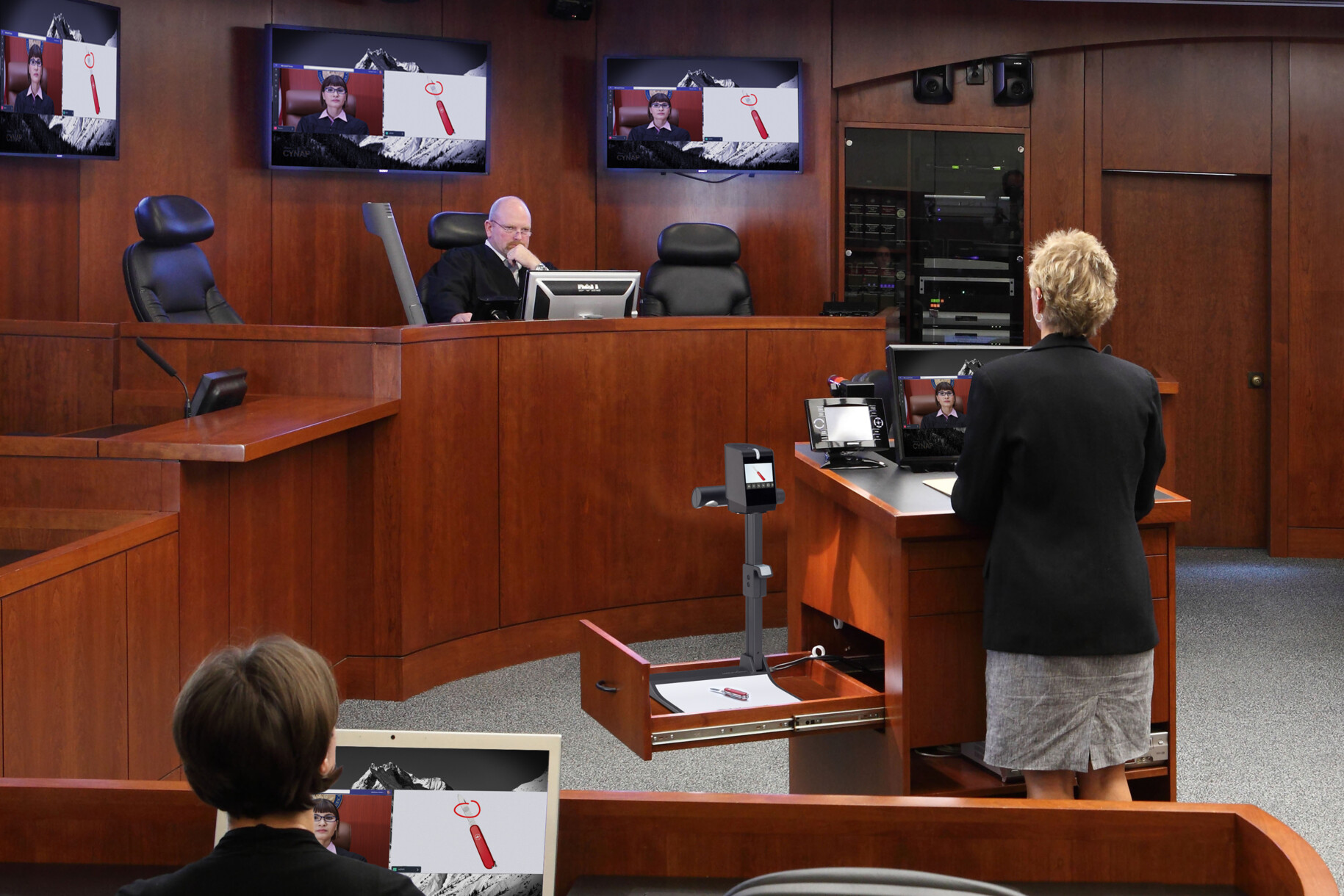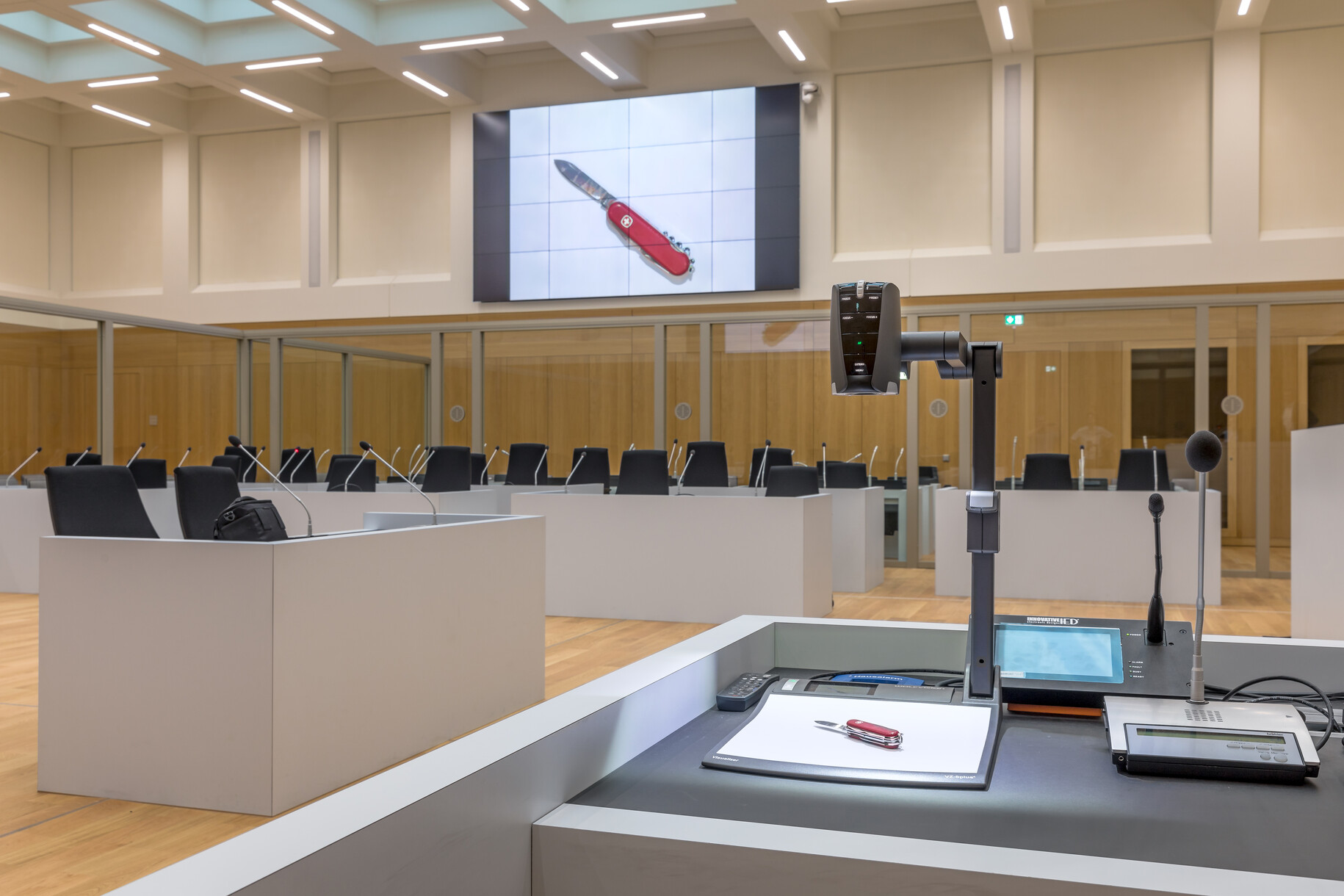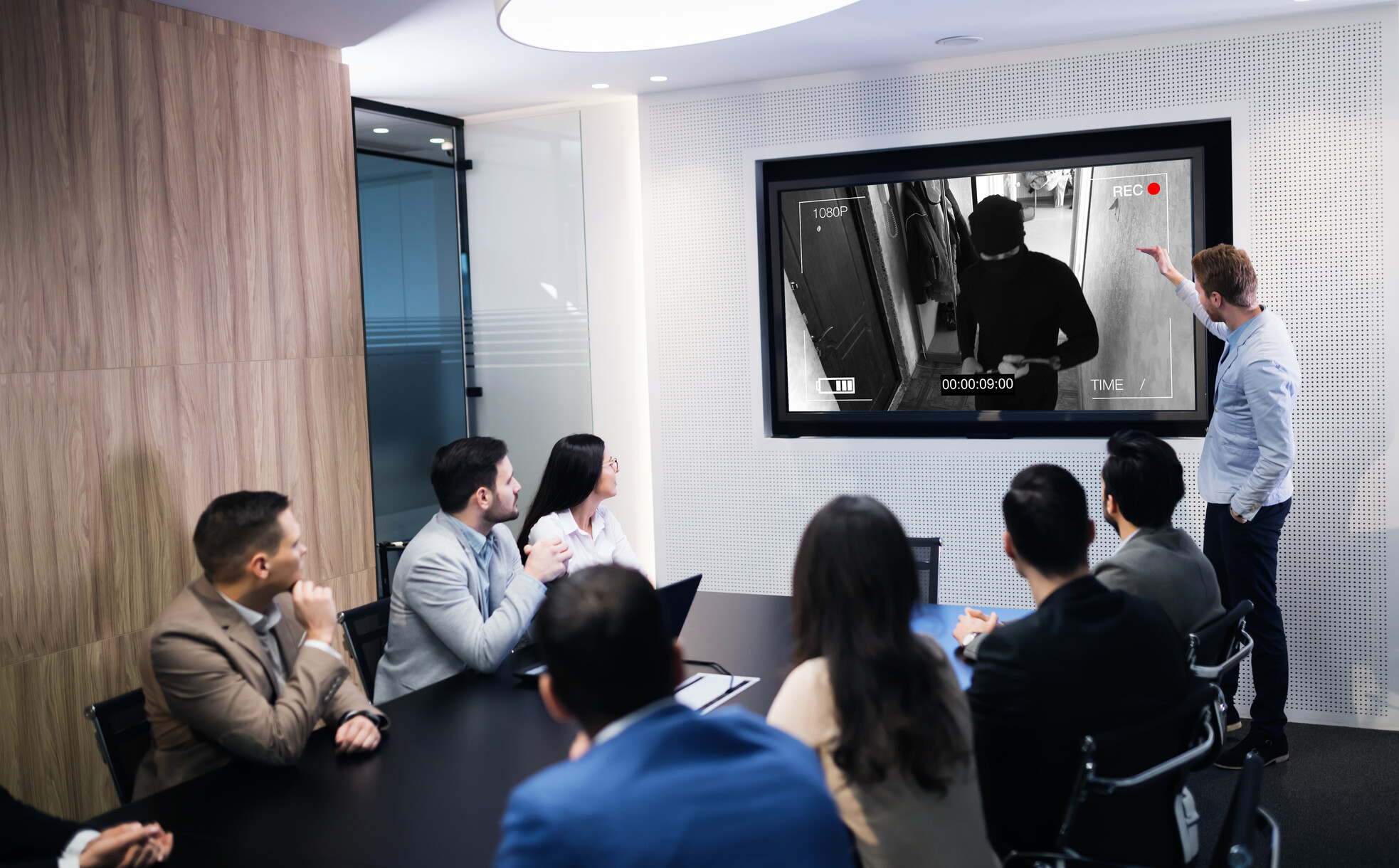Tomorrow's Courtroom AV Solutions Today
Importance of Courtroom AV Systems
In the rapidly evolving landscape of judicial processes, the integration of advanced courtroom AV systems has become essential. These technologies are not only revolutionizing the way legal proceedings are conducted but also helping to ensure that justice is served more efficiently and transparently.
With the advent of digital courtrooms, the presentation of evidence, recording of testimonies, and overall courtroom management have significantly improved, addressing many long-standing challenges in the judicial system. WolfVision, a leader in innovative presentation and collaboration solutions, is at the forefront of this transformation. By providing state-of-the-art courtroom AV infrastructure, WolfVision is committed to enhancing the efficiency, clarity, and accessibility of legal proceedings.
This article explores how AV technology is transforming courtrooms today, ensuring that the judiciary can meet the demands of modern justice.

1: Courtroom AV Systems: Meeting the Challenges
Traditional courtrooms often face a range of challenges that can hinder the efficiency and effectiveness of legal proceedings. These issues include:
- Inefficiencies: Manual processes and outdated equipment can slow down courtroom proceedings, leading to longer case resolution times and creation of backlogs.
- Accessibility Problems: Ensuring that all participants, including remote attendees or those with special needs, have equal access to courtroom activities is a persistent challenge.
- Technological Gaps: Many courtrooms still rely on outdated technology that lacks the capabilities required for modern legal processes, such as high-definition video conferencing and digital evidence presentation.
Courtroom AV systems play a crucial role in addressing these challenges by providing comprehensive solutions that enhance every aspect of courtroom operation. For example:
- Enhanced Efficiency: Automated systems and digital tools streamline courtroom procedures, reducing the time needed for case management and evidence presentation.
- Improved Accessibility: Advanced AV systems ensure that everyone, regardless of their location or physical abilities, can participate fully in courtroom proceedings. This includes features like assistive listening devices, real-time transcription, and high-quality video conferencing.
- Bridging Technological Gaps: By integrating the latest judicial AV systems, courtrooms can leverage high-definition displays, advanced audio systems, and interactive tools to ensure that all evidence is presented clearly and accurately.

2: Digital and Analog Evidence Display Requirements in Modern Courtrooms
In today's courtrooms, the ability to seamlessly display both digital and analog evidence is paramount. Effective courtroom AV solutions must cater to the diverse needs of legal professionals, ensuring that all types of evidence are presented clearly and efficiently. This dual capability enhances the overall effectiveness of legal proceedings and ensures that justice is served with the highest level of transparency and accuracy.
Digital Evidence Presentation
Digital evidence encompasses a wide range of formats, including multimedia presentations, digital documents, and real-time data streams. To handle these varied formats, modern courtrooms require robust digital presentation systems that provide:
- High-Definition Displays: Essential for presenting clear and detailed digital evidence, high-definition displays ensure that all courtroom participants can see the information accurately, regardless of their position in the room.
- Wireless Presentation Capabilities: Systems like the Cynap product line by WolfVision enable wireless sharing of multimedia content from any device, facilitating smooth and hassle-free transitions between different types of digital evidence.
- Interactive Tools: Digital annotation and interactive tools allow legal professionals, witnesses or others to highlight and emphasize critical aspects of the evidence during presentations, enhancing clarity and understanding.
- Secure Data Handling: Ensuring the confidentiality and integrity of digital evidence is crucial. Modern AV systems must include secure data transfer and storage solutions to protect sensitive information.
Analog Evidence Presentation
Despite the increasing digitization of evidence, many legal proceedings still rely on physical documents, photographs, and tangible objects. To effectively integrate these materials into the digital courtroom environment, high quality document cameras are essential:
High-Resolution Document Cameras / Visualizers, like those offered by WolfVision provide superior image clarity and powerful zoom capabilities, ensuring that documents and objects can be displayed in fine detail.
The Best of Both Worlds: Integrated AV Solutions
For a courtroom to function optimally, it must seamlessly integrate both digital and analog evidence presentation capabilities. Comprehensive AV solutions should provide:
- Integrated Control Systems: Centralized control systems that allow for easy switching between digital and analog evidence presentations, ensuring smooth and efficient courtroom operations.
- Unified Presentation Platforms: Platforms that support the simultaneous display of digital and analog evidence on multiple screens, enhancing the ability to compare and contrast different types of information in real-time.
- User-Friendly Interfaces: Intuitive interfaces that enable legal professionals to manage evidence presentations with minimal training, reducing the risk of technical difficulties during proceedings.
By addressing the specific requirements for displaying both digital and analog evidence, modern courtroom presentation systems ensure that all forms of evidence are presented effectively. This comprehensive approach not only improves the efficiency and clarity of legal proceedings but also upholds the integrity of the judicial process.

3: Effective Evidence Presentation Technology
Clear and effective evidence presentation is critical in courtrooms, ensuring that all participants, including judges, jurors, and attorneys, can thoroughly examine and understand the presented materials. Proper evidence presentation enhances transparency, aids in the accurate interpretation of facts, and ultimately contributes to fair and just legal proceedings.
Supporting Existing Courtroom Processes and Workflows
Modern AV technology must support and enhance existing courtroom processes and workflows without disrupting them. This includes providing tools that integrate seamlessly with traditional methods, ensuring that the transition to advanced systems is smooth and intuitive for legal professionals. Key considerations include:
- Maintaining Control Over Evidence Presentation: It's vital that legal professionals retain full control over when and how evidence is displayed. This prevents accidental disclosure of sensitive information to the wrong parties, which could compromise the integrity of the trial.
- Seamless Integration: AV solutions must be compatible with existing courtroom technologies and procedures. This includes the ability to handle both digital and analog evidence seamlessly, ensuring that all types of materials can be presented effectively.
- Flexibility and Reliability: Courtroom technology needs to be reliable and flexible, adapting to different case requirements and courtroom setups without causing delays or technical issues.
The Importance of Controlled Evidence Presentation
The ability to control the presentation of evidence is crucial in maintaining the integrity and flow of courtroom proceedings. Missteps in evidence handling, such as presenting sensitive material to unauthorized parties, can lead to mistrials or appeals, undermining the judicial process. Effective AV solutions should:
- Prevent Unauthorized Viewing: Ensure that evidence is only visible to the intended audience at the appropriate time, maintaining the confidentiality and integrity of the proceedings.
- Enable Selective Display: Allow legal professionals to choose what evidence to display and when, providing the flexibility to respond to the dynamics of the courtroom environment.
- Facilitate Real-Time Adjustments: Offer the ability to make real-time adjustments to presentations, including annotations and highlights, to better illustrate key points and respond to courtroom developments.
- Centralized Control: Popular solutions like vSolution MATRIX from WolfVision allow legal professionals to manage multiple displays from a single control point, ensuring that evidence is shown to the right audience at the right time.
- Secure and Flexible Sharing: The system supports secure, flexible sharing of content across multiple screens and devices, allowing for both public and private viewing of evidence as needed.
- High-Quality Visuals: It delivers high-definition visuals, ensuring that all evidence is presented with the clarity required for thorough examination and understanding.
- Scalable and Adaptable: Systems such as vSolution MATRIX can be scaled to fit the specific needs of any courtroom, whether it’s a small local court or a large federal courtroom with multiple participants.

4: Comprehensive Courtroom Audio Visual Solutions
WolfVision offers a diverse range of AV solutions designed to enhance the functionality and efficiency of modern courtrooms. These solutions include advanced Visualizers, wireless presentation systems, and collaboration tools. By integrating WolfVision products with existing or upgraded technologies from other vendors—such as AV recording systems, courtroom sound systems, microphones, and assistive listening devices—WolfVision ensures that courtrooms operate with maximum efficiency and effectiveness.
Enhancing Courtroom Processes
By integrating WolfVision’s visualizers and wireless presentation systems with other essential courtroom technologies, such as AV recording systems and courtroom sound systems, courtrooms can achieve a higher level of operational efficiency and clarity. This comprehensive approach ensures that all forms of evidence, whether digital or analog, are presented effectively and securely, maintaining the integrity of the judicial process.
- Controlled Evidence Sharing: WolfVision’s solutions allow legal professionals to control when and how evidence is shared on-screen, preventing unauthorized access and ensuring that sensitive information is disclosed appropriately.
- Enhanced Collaboration: Wireless presentation systems enable seamless collaboration between courtroom participants, facilitating the sharing of multimedia content and real-time annotations that enhance the understanding of evidence.
- Improved Accessibility: By integrating assistive listening devices and other accessibility tools, courtrooms can ensure that all participants, including those with special needs, have equal access to the proceedings.
By offering comprehensive and integrated AV solutions, WolfVision enhances the efficiency, clarity, and accessibility of courtroom proceedings. These technologies not only improve the presentation and interpretation of evidence but also ensure that all participants can engage fully in the judicial process.

5: Enhancing Courtroom Video Conferencing
The importance of video conferencing in modern courtrooms cannot be overstated. As legal proceedings continue to evolve, the ability to conduct hearings and trials remotely has become a crucial component of the judicial system. Video conferencing solutions provide numerous benefits, including increased accessibility, enhanced efficiency, and greater flexibility in managing courtroom operations.
- Remote Participation: Video conferencing allows participants who are unable to be physically present in the courtroom—such as witnesses, experts, and even defendants—to participate in proceedings from remote locations. This is particularly beneficial for individuals who may have mobility issues, reside in different geographic areas, or face travel restrictions.
- Inclusivity: By enabling remote participation, video conferencing ensures that all relevant parties can be involved in the judicial process, thereby promoting inclusivity and ensuring that justice is accessible to all.
- Time and Cost Savings: Video conferencing reduces the need for travel, which can save significant time and costs associated with transportation and accommodation. This efficiency gain is beneficial for all courtroom participants, including attorneys, witnesses, and court staff.
- Streamlined Scheduling: Scheduling hearings and trials becomes more flexible with video conferencing. Courtrooms can accommodate more cases and adapt to the availability of remote participants, leading to a more streamlined judicial process.
- Hybrid Courtrooms: The integration of video conferencing technology enables a hybrid courtroom to be created. This means that some participants are present in person while others join remotely. This flexibility is particularly valuable in situations where full in-person attendance is not feasible or safe.
- Continuity of Operations: In times of emergencies, such as natural disasters or pandemics, video conferencing ensures that court operations can continue without significant disruption. This continuity is essential for maintaining the rule of law and ensuring timely access to justice.
Video Conferencing Benefits in Judicial Settings
- Secure and Private Communications: Modern video conferencing platforms offer robust security features, ensuring that sensitive information shared during court proceedings is protected.
- Improved Record-Keeping: Video conferencing setups are often integrated with recording systems, allowing for accurate documentation of proceedings. This is valuable for creating records that can be reviewed for accuracy and accountability.
- Enhanced Interaction: Features such as real-time messaging, screen sharing, and virtual breakout rooms facilitate better interaction and collaboration among courtroom participants, making it easier to manage complex cases and discussions.
Implementing Video Conferencing in Courtrooms
The rapid adoption of video conferencing in judicial settings is driven by its ability to enhance the overall efficiency and accessibility of court operations. Key steps in implementing these solutions include:
- Assessing Technological Needs: Courts should evaluate their specific requirements, including the number of participants, the type of cases handled, and the existing technological infrastructure.
- Selecting Suitable Platforms: Choosing the right video conferencing platform that meets security, usability, and integration needs is crucial for successful implementation.
- Training and Support: Providing comprehensive training and ongoing support to court staff and legal professionals ensures that the technology is used effectively and any issues are promptly addressed.

Summary
In this article, we've explored the transformative role of advanced courtroom AV systems in modernizing judicial processes. These technologies are essential for improving the efficiency, clarity, and accessibility of legal proceedings. Traditional courtrooms face numerous challenges, including inefficiencies, accessibility problems, and technological gaps. WolfVision’s cutting-edge AV solutions address these issues by offering enhanced efficiency, improved accessibility, and the ability to bridge technological gaps.
WolfVision’s comprehensive AV solutions, when combined with other essential courtroom technologies, enhance the overall efficiency, clarity, and accessibility of legal proceedings. These integrated systems ensure that all participants can engage fully in the judicial process, upholding the principles of modern justice.
